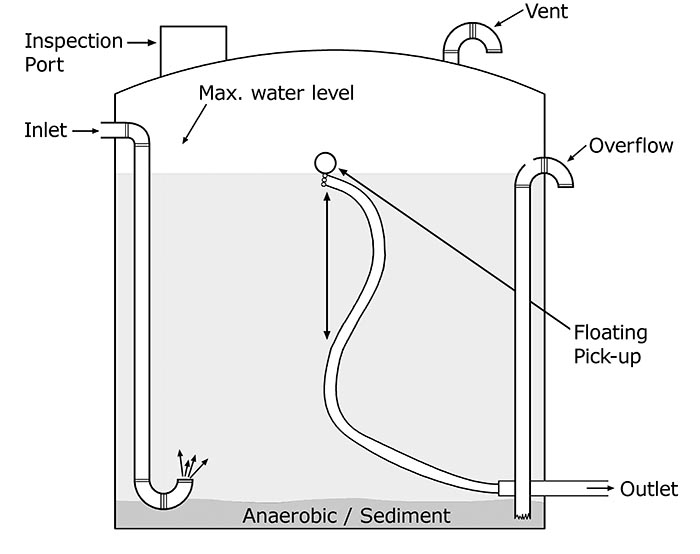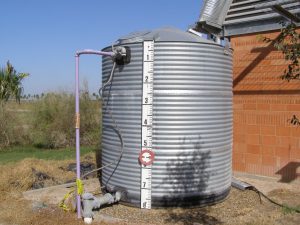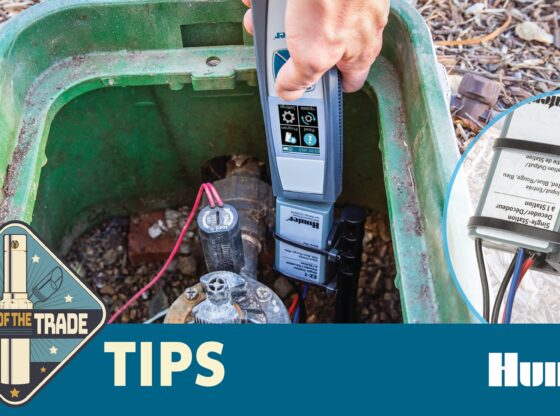Harvesting water is great, but to be effective you must store it. Storage can be a subterranean cavity or tank, an above ground tank, or in a pond. When using an above ground tank there are some things to consider.

Water Inlet
Water needs to enter the tank from the collection area. Pre-screening is advised to keep debris from entering the tank. The inlet will be located towards the top of the tank. Suggest a calming pipe as shown in the diagram. This allows water to enter and not stir up the sediments collected at the bottom of the tank.
Water Outlet
There is also a need for an outlet. If the outlet is located at the top of the tank, this necessitates a pump to remove water. The pump can be a submersible located inside the tank or a suction lift centrifugal located on top of the tank. The pump will have to handle the pressure and flow requirements to move water from the tank and provide for the irrigation system.
If the outlet is located near the bottom then water can exit via gravity. Gravity fed systems will still need a pump for irrigation purposes. However the pump will be functioning as a flooded suction booster pump to provide the pressure and flow for the irrigation system. It will be smaller and much easier to install and maintain compared to a suction lift or submersible pump exiting through the top of the tank.
For irrigation purposes it is good to have a floating screen outlet like shown in the diagram. This help keep debris from entering the irrigation system.
Overflow
All tanks need an overflow to discharge excess water to a drainage point. Best if the  overflow draws water from the bottom of the tank using a gooseneck pipe as illustrated in the diagram. The gooseneck pipe must have a hole in the top elbow to avoid a siphoning effect.
overflow draws water from the bottom of the tank using a gooseneck pipe as illustrated in the diagram. The gooseneck pipe must have a hole in the top elbow to avoid a siphoning effect.
Additionally, the overflow discharge level must be slightly lower than the inlet level. Be sure a screen covers the outside opening to keep insects and animals from entering the tank.
Vent
To avoid a vacuum a vent is installed in the top of the tank. Be sure a screen covers the outside opening to keep insects and animals from entering the tank.
Inspection and/or Entry Ports
It is necessary to either see into the tank or enter the tank. Thus the entry or inspection port is important. Tanks sometimes need cleaned of debris. Submersible pumps may need work. If the tank is large enough for a person to enter, there are codes and regulations that must be followed when working inside tanks. So, safety first!
All ports must be secured so unauthorized persons cannot enter. Don’t take the chance of a child getting into a tank and drowning.
Other Tank Components
Depending on the pumping arrangements, there may be other devices installed in the tank. Some of those devices may be sensors for water level, float switches, temperature, or others. Valves, screening, and other piping may also be present.
In conclusion, an effective water harvesting requires a water tank. Use caution and follow the rules and regulations put in place. Happy harvesting!












I like what this article mentions about the tanks often times having debris blocking the entrance. It makes sense that with something like a storm water tank, there’s bound to be a pile up of leaves or sticks. It’s something to remember for getting a tank in my yard as I have quite a few trees that drop leaves year round. Thanks for sharing!